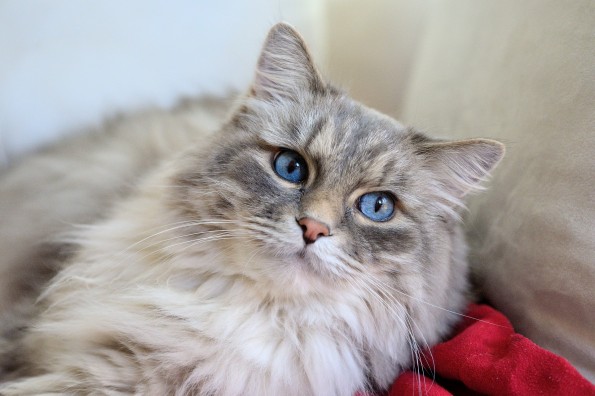
Cats are meticulous groomers, so we often put off or neglect to provide some basic grooming needs like brushing. However, there are many reason that a cat may be unable to effectively groom themselves, particularly along their mid-spine, armpits, and behind the ears. Conditions such as arthritis, dental pain, and obesity can make it difficult or even painful to continue their strict grooming routines.
Cats need to be trained to accept brushing with reward based training techniques. The earlier we start and the more positive the experience is for our cat the better. If we wait and start brushing with older cats, they will likely be less than accepting of us invading their space with a sharply bristled object.
How often should you groom your cat? Brushing removes loose hairs, dead skin cells, debris, and promotes the distribution of natural skin oils along the coat that helps detour hair from becoming tangled. If you have a short-haired cat stretching to every few days and making sure to do a thorough job may be more likely for you to stick with a grooming routine. Long haired cats need to be brushed daily. Even with daily brushing their hair can quickly get out of control. Deshedding tools can be used with caution, depending on the cat’s temperament and the condition of their skin, about once a month. During periods where your cat is shedding more or you are noticing more knots forming, try using a flea comb weekly to brush out their undercoat (the fine fluffy hairs, you find all over your furniture and clothes). In general periods of excess shedding happen in the late spring and late fall. It is not uncommon to see clumps of hair coming out as cats shed their undercoat. For people with mild cat allergies, daily brushing reduces the amount of airborne allergens enough that you should be able to share your home with a cat.
What are mats? Without regular brushing matting will occur. Mats are tangled clumps of hair similar to dreadlocks. They are lumpy and irritating for your cat, particularly when located in sensitive areas that pull with movement. They also prevent oxygen from reaching the skin, causing inflammation and the potential for skin infections. In severe cases mats can even cause the tissue underneath to die, and attract maggots. Mats are very painful to remove by brushing, with too much force we can actually tear their delicate skin before the matt even releases. Never bath your cat before removing matted fur. When cat fur gets wet these mats tighten and become impossible to remove.
What do you do? When matting is first noted it is a good idea to bring your cat in to have the small matt clipped while it can be done quickly and the cat not require sedation. For heavily matted cats dealing with this can involve an anesthetic and hours of careful shaving. Often these cats will require all their hair to be removed from their body, tail, and sometimes their legs. This is referred to as a lion cut. Unlike dogs, cats require very fine bristled grooming blades, anesthesia, and lots of time, expect to be investing a lot more than a typical dog groom. After the procedure training your cat to accept a brush is critical. The goal is that the cat will only need one groom to get things back on track and then with regular brushing and monitoring for small matts this extensive procedure will not be needed again.
